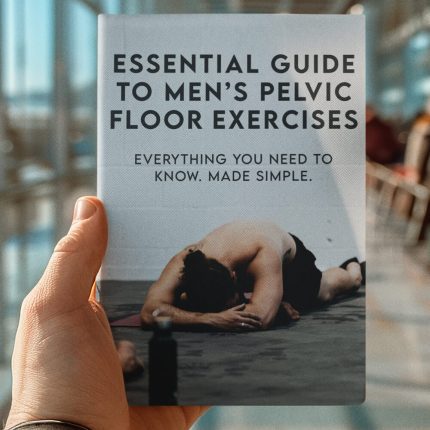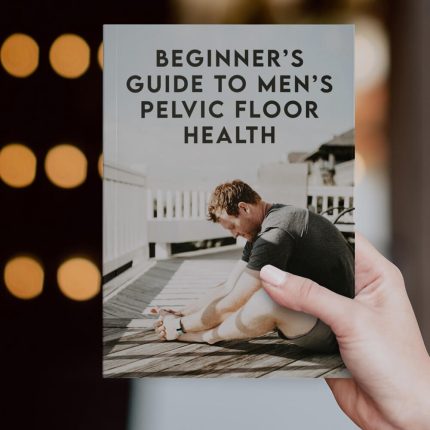
Pelvic Floor Therapy
Beginner’s Guide to Men’s Kegel Exercises

Picture this: you’re scrolling through your favorite social feed when you stumble upon a post about men’s Kegel exercises, and instead of yawning, you lean in a little closer, curiosity piqued by the promise of enhanced core strength, better urinary control, and a surprising boost in confidence. This isn’t your typical gym routine; it’s a secret weapon hidden in plain sight for Gen-Z and millennial men who are ready to challenge stereotypes, defy expectations, and elevate their pelvic floor game.
Quick Links to Useful Sections
- Unpacking the Basics of Men’s Kegel Exercises
- Why Men’s Kegel Exercises Matter: The Science and Benefits Behind the Movement
- Debunking Myths: Men, Kegels, and Masculinity
- Step-by-Step Guide to Mastering Men’s Kegel Exercises
- Step 1: Identify the Right Muscles
- Step 2: Perfect Your Technique
- Step 3: Create a Routine
- Step 4: Elevate the Challenge
- The Role of Technology: Apps, Devices, and Tools to Supercharge Your Kegels
- Common Pitfalls and How to Avoid Them
- Integrating Kegels Into a Broader Men's Pelvic Health Routine
- Nutrition and Lifestyle: Fueling Your Pelvic Power
- Power Foods for a Strong Pelvic Floor
- Lifestyle Tweaks That Make a Difference
- Pro Tips to Stay Motivated and Engaged
- Addressing Concerns: When to Seek Professional Guidance
- Resources and Community Support: Your Next Steps
- Online Forums and Support Groups
- Health and Fitness Apps
- Webinars and Expert Talks
- Local Health Clinics and Physiotherapy Centers
- Breaking It Down: Incorporating Men’s Kegels Into Your Daily Life
- Practical Tips and Tricks for Sustained Success
- Frequently Asked Questions About Men’s Kegel Exercises
- Your Journey to Empowered Pelvic Health: Next Steps for Lifelong Wellness
Unpacking the Basics of Men’s Kegel Exercises
Let’s break it down: Kegel exercises aren’t just for women. Originally designed to strengthen the pelvic floor muscles, men’s Kegels focus on the same group of muscles that support your bladder, bowels, and, yes, the prostate. Think of these muscles as your internal core, working behind the scenes to maintain your pelvic health, enhance your sexual performance, and keep pesky issues like incontinence at bay.
For men, a strong pelvic floor means more than just physical strength; it’s about reclaiming control over bodily functions, improving posture, and even bolstering your self-confidence. In an age where every feature of personal wellness matters, understanding and investing in your pelvic floor is a smart move that pays off in surprising ways.
Why Men’s Kegel Exercises Matter: The Science and Benefits Behind the Movement
You might be thinking, “Are these exercises really going to change the game for me?” The answer is a resounding yes. Kegel exercises cultivate a foundation of strength that directly impacts several key areas of your health:
- Urinary Health: By regularly engaging your pelvic floor muscles, you can reduce the risk of urinary incontinence and manage conditions like an overactive bladder.
- Prostate Health: Men who perform Kegels often see improvements in prostate health and a reduction in discomfort associated with conditions like prostatitis.
- Enhanced Sexual Performance: Improved muscle control translates into more robust sexual performance, including longer-lasting erections and increased sexual stamina.
- Core Stability: A strong pelvic floor complements your core muscles, contributing to better balance, posture, and overall physical coordination.
- Improved Recovery: Whether you’re recovering from surgery or just looking to maintain optimal health, consistency with these exercises can aid in quicker rehabilitation and enhanced body mechanics.
The beauty of men’s Kegel exercises lies in their simplicity and effectiveness. With just a few minutes a day, you can cultivate a resilient pelvic floor that supports your body in countless ways.
Your pelvic floor affects how you move, how you use the bathroom, and how sex feels, yet most men are never taught how it works. This essential guide explains your pelvic floor in plain language and gives you a simple plan to relax, strengthen, and look after it at home.
Youll Learn How To:
- Understand what your pelvic floor does for bladder control, posture, and sex
- Spot signs of tension, weakness, and poor coordination
- Use breathing, reverse Kegels, and classic Kegels safely
- Improve habits for sitting, lifting, sport, sleep, and stress
Whats Inside: friendly explanations, safety guidelines, daily drills, sex function tools, flare up plans, and a complete twelve week program with trackers.
Perfect For: men of all ages who want less pelvic tension, fewer leaks, better comfort on the toilet, and more confidence in movement and in the bedroom.
Debunking Myths: Men, Kegels, and Masculinity
There’s a lot of misinformation swirling around the idea that Kegels are “feminine” or irrelevant to men. Let’s set the record straight: real strength comes from a well-rounded approach to fitness that includes all major muscle groups, even those you can’t see. Men’s pelvic floor muscles are essential for core stability, bladder control, and even sexual performance. Embracing Kegel exercises doesn’t take away your masculinity; it enhances your physical potential.
Think of it as leveling up your wellness routine in a world where self-care isn’t just a buzzword, it’s a lifestyle. Men, it’s time to break the stigma and start building physical resilience from the inside out.
Step-by-Step Guide to Mastering Men’s Kegel Exercises
Let’s get practical. The beauty of Kegel exercises is their simplicity, yet performing them correctly is key to unlocking their full potential. Here’s how to get started:
Step 1: Identify the Right Muscles
The first step is like a personal treasure hunt, finding your pelvic floor muscles. The easiest way to identify these muscles is to try stopping your urine midstream. When you do, you’re engaging the pelvic floor. Don’t worry, this isn’t a plan for your next bathroom break challenge; it’s just a one-time test to familiarize yourself with the sensations.
Step 2: Perfect Your Technique
Once you know where your pelvic floor is, it’s time to isolate and target these muscles. Sit comfortably or lie down on your back. Tighten your pelvic floor muscles for about 5 seconds, then relax for 5 seconds. Focus on using only those muscles, not your glutes, abdomen, or thighs. If you find yourself engaging the wrong muscles, take a step back and try again.
Step 3: Create a Routine
Consistency is key. Aim for three sets of 10 repetitions a day, gradually increasing the hold time as your strength improves. Integrate these sessions into your morning routine, during your lunch break, or even at night, whatever fits into your day. The goal is to make these exercises as habitual as scrolling through your socials.
Step 4: Elevate the Challenge
As you build strength, introduce variations like reverse Kegels, which involve relaxing the pelvic floor muscles fully after a contraction. This nuance can improve control and flexibility. You might also experiment with different positions, standing, sitting, or lying down, to discover what works best for your body.
Remember, like mastering any new skill, your progress might be gradual. Track your sessions, be patient, and celebrate small wins along the way.
EXPLORE OUR EXPERT MEN'S PELVIC FLOOR GUIDES WITH HIDDEN TIPS AND TRICKS
👨💻 Men's Pelvic Floor Book Store (Instant Download) 👨💻
The Role of Technology: Apps, Devices, and Tools to Supercharge Your Kegels
In the digital age, why not let technology lend a hand (or a beep) in your journey to better pelvic floor health? There are apps and biofeedback devices specifically designed to guide you through your Kegel exercises. These digital tools provide real-time feedback, helping you fine-tune your techniques for maximum effectiveness.
Some popular apps come with customizable reminders, exercise tracking, and even guided meditation sessions to keep you motivated. Devices like biofeedback monitors attach discreetly and provide visual or auditory cues during your workouts. Embracing these modern solutions can turn your pelvic health routine into an interactive and engaging part of your daily self-care ritual.
Your pelvic floor affects how you move, how you use the bathroom, and how sex feels, yet most men are never taught how it works. This essential guide explains your pelvic floor in plain language and gives you a simple plan to relax, strengthen, and look after it at home.
Youll Learn How To:
- Understand what your pelvic floor does for bladder control, posture, and sex
- Spot signs of tension, weakness, and poor coordination
- Use breathing, reverse Kegels, and classic Kegels safely
- Improve habits for sitting, lifting, sport, sleep, and stress
Whats Inside: friendly explanations, safety guidelines, daily drills, sex function tools, flare up plans, and a complete twelve week program with trackers.
Perfect For: men of all ages who want less pelvic tension, fewer leaks, better comfort on the toilet, and more confidence in movement and in the bedroom.
Integrating technology not only fine-tunes your performance but also transforms a solo practice into an experience that’s as dynamic as it is empowering.
Common Pitfalls and How to Avoid Them
Even the best intentions can sometimes lead to subpar results if you fall into common mistakes. Here are some pitfalls to watch out for when starting your men’s Kegel exercise journey:
- Overexertion: Just because you can contract those muscles doesn’t mean you should overdo it. Like any workout, balance is crucial. Overworking your pelvic floor can lead to muscle fatigue or even pelvic pain.
- Incorrect Muscle Engagement: Avoid contracting your abdomen, glutes, or thighs. Focusing solely on the pelvic floor ensures you’re targeting the right muscles. If you’re unsure, consider seeking guidance from a pelvic health specialist.
- Skipping the Relaxation Phase: A full cycle of contraction and relaxation is essential. Neglecting the release phase can keep your muscles in a constant state of tension, which might lead to discomfort.
- Inconsistency: Sporadic practice won’t build lasting strength. Incorporate Kegels into your daily routine, and be steady with your practice to see continuous improvements.
By avoiding these common missteps, you’re setting yourself up for success. A mindful, consistent approach is key to reaping the full benefits of your Kegel exercises.
Integrating Kegels Into a Broader Men's Pelvic Health Routine
Men’s pelvic health isn’t just about isolated exercises, it’s about weaving pelvic floor strength into a broader fabric of wellness. Alongside Kegels, consider adding complementary activities and habits to round out your routine:
- Cardiovascular Workouts: Keep your heart healthy and your body in motion. Activities like running, cycling, or swimming not only benefit overall fitness but also support circulatory health, which can indirectly aid muscle recovery.
- Strength Training: Incorporate core exercises that engage your abs, obliques, and back muscles. A balanced core improves posture and enhances the effectiveness of your pelvic floor workouts.
- Flexibility and Mobility: Engage in stretching routines, yoga, or Pilates to ensure your muscles stay supple and responsive. Flexibility plays a vital role in preventing strain during daily activities.
- Mindfulness and Stress Management: Managing stress is key to overall wellness. Practices like meditation, deep breathing, or even a chilled-out playlist can lower stress hormones that might otherwise contribute to muscle tension.
By integrating Kegels with other forms of exercise and wellness practices, you create a comprehensive plan that addresses not only your pelvic floor but your entire body. This holistic approach is especially appealing to a generation that values versatility and balance in their health routines.
EXPLORE OUR EXPERT MEN'S PELVIC FLOOR GUIDES WITH HIDDEN TIPS AND TRICKS
👨💻 Men's Pelvic Floor Book Store (Instant Download) 👨💻
Nutrition and Lifestyle: Fueling Your Pelvic Power
It turns out your diet plays a stealthy yet significant role in how well you perform your Kegel exercises. A nutrient-dense, balanced diet supports muscle repair, reduces inflammation, and supplies the energy needed for consistent workouts.
Power Foods for a Strong Pelvic Floor
Optimize your plate with foods that reduce inflammation and promote muscle health. Think fresh fruits, leafy greens, lean proteins (like chicken, fish, and plant-based options), and whole grains. Incorporating anti-inflammatory spices such as turmeric and ginger can also be beneficial. Hydration is key, aim to drink plenty of water throughout the day to keep your muscles supple and well-nourished.
Lifestyle Tweaks That Make a Difference
While honing your Kegel technique, don’t forget the small yet mighty changes that support overall pelvic health:
- Sit Right: Good posture isn’t just for selfies. Proper alignment reduces strain on your pelvic region.
- Manage Stress: Regular relaxation techniques, such as meditation or a tech-free time-out, can work wonders in keeping your muscles relaxed and receptive.
- Sleep Like a Boss: Aim for 7-9 hours per night. A quality night’s sleep is as crucial for muscle recovery as your morning Kegels.
These lifestyle choices, combined with a smart nutritional plan, amplify the benefits of your Kegel exercises, ensuring that every effort you put in translates into long-term pelvic power.
Pro Tips to Stay Motivated and Engaged
Let’s be real: starting a new routine can feel a bit like signing up for a boring class. But with the right mindset and some creative thinking, you can transform your Kegel sessions into a dynamic part of your day. Here are some pro tips to keep the motivation high:
Your pelvic floor affects how you move, how you use the bathroom, and how sex feels, yet most men are never taught how it works. This essential guide explains your pelvic floor in plain language and gives you a simple plan to relax, strengthen, and look after it at home.
Youll Learn How To:
- Understand what your pelvic floor does for bladder control, posture, and sex
- Spot signs of tension, weakness, and poor coordination
- Use breathing, reverse Kegels, and classic Kegels safely
- Improve habits for sitting, lifting, sport, sleep, and stress
Whats Inside: friendly explanations, safety guidelines, daily drills, sex function tools, flare up plans, and a complete twelve week program with trackers.
Perfect For: men of all ages who want less pelvic tension, fewer leaks, better comfort on the toilet, and more confidence in movement and in the bedroom.
- Mix It Up: Incorporate variations and challenge yourself with longer holds or faster reps over time. Routine doesn’t have to be monotonous, think of it as a personal mini-workout session that can be done anywhere.
- Track Your Progress: Use a journal or a dedicated app to monitor improvements. There’s nothing more gratifying than watching your strength build day by day.
- Join a Community: Seek out online forums, social media groups, or local wellness communities. Sharing progress, tips, and even funny stories about your workout mishaps creates a supportive environment.
- Reward Yourself: Set milestones and treat yourself when you hit them. Whether it’s a new workout tee or a favorite snack, small rewards reinforce your habit.
Remember, consistency is key. The more you integrate these exercises into your daily habits, the faster they become second nature, and soon enough, you’ll be reaping the rewards without even thinking about it.
Addressing Concerns: When to Seek Professional Guidance
While many men can start Kegels at home, there are cases when you might need professional input. If you’re experiencing persistent pelvic pain, difficulty identifying the right muscles, or if you’ve undergone recent pelvic surgery, it’s a good idea to consult a pelvic health specialist. They can provide a comprehensive assessment and tailor a program that safely increases your strength.
In some instances, working with a physical therapist specialized in men’s pelvic health can ensure your technique is on point and help navigate any complications early on. Remember: prioritizing safety and proper form now means enjoying the long-term benefits with minimal risks.
EXPLORE OUR EXPERT MEN'S PELVIC FLOOR GUIDES WITH HIDDEN TIPS AND TRICKS
👨💻 Men's Pelvic Floor Book Store (Instant Download) 👨💻
Resources and Community Support: Your Next Steps
You’re not in this alone, there’s a whole community of men, healthcare professionals, and digital experts ready to support you on your journey toward pelvic health mastery. Here are some resources to keep you motivated and informed:
Online Forums and Support Groups
Numerous online groups are dedicated to men’s pelvic health and wellness. Platforms like Reddit and dedicated Facebook groups provide spaces where you can ask questions, share successes, and exchange tips on everything from perfecting your Kegels to integrating a broader fitness routine.
Health and Fitness Apps
There are several cutting-edge apps that track your progress, send reminders, and even offer guided routines for pelvic floor exercises. These apps can be your virtual coach, keeping you accountable and celebrating your improvements along the way.
Webinars and Expert Talks
Look for webinars hosted by pelvic health specialists or fitness influencers who specialize in men’s wellness. These sessions often offer practical tips, live demonstrations, and Q&A segments where you can learn the most up-to-date methods and research on Kegels.
Local Health Clinics and Physiotherapy Centers
If you prefer face-to-face guidance, many local clinics now offer specialized pelvic floor therapy sessions for men. These centers not only provide personalized exercise programs but also integrate complementary therapies such as biofeedback, nutritional counseling, and stress management workshops.
Empowering yourself with knowledge and joining a supportive network is essential. By connecting with like-minded individuals and experts in the field, you reinforce your commitment to a healthier, stronger pelvic floor, and ultimately, a healthier you.
Breaking It Down: Incorporating Men’s Kegels Into Your Daily Life
As you move forward in your men’s Kegel journey, keep in mind that every small effort counts. Whether you're squeezing in a quick set between Zoom meetings or dedicating time in the morning to focus entirely on your pelvic core, each moment builds towards a foundation of strength. Transform your routine into a series of micro-meditations that not only enhance physical health but also boost your mental clarity and self-esteem.
The goal is to create a ripple effect: as your pelvic health improves, you’ll notice benefits across your life, from less stress and better focus to more robust physical performance in everything you do. Embrace each moment, knowing that you’re investing in a holistic approach to men’s wellness that’s built to last.
Practical Tips and Tricks for Sustained Success
Let’s talk about how to keep those gains going strong. Here are some practical tips that will help you maintain a consistent and effective Kegel routine:
- Create Visual Reminders: Set a daily alarm or place sticky notes in your living space to remind you to take a moment for your pelvic exercises.
- Pair with Daily Habits: Sync your Kegels with routine activities, maybe during your morning coffee or while winding down with a podcast in the evening.
- Keep It Fun: Gamify your process. Track your progress with an app that gives you badges or rewards for your consistency.
- Celebrate Mini Milestones: Whether it’s a week of consistency or noticeable improvements in muscle control, take time to acknowledge your successes. Self-affirmations go a long way!
With these strategies, your Kegel exercises become less of a chore and more of an empowering lifestyle habit that integrates seamlessly into your day-to-day routine.
EXPLORE OUR EXPERT MEN'S PELVIC FLOOR GUIDES WITH HIDDEN TIPS AND TRICKS
👨💻 Men's Pelvic Floor Book Store (Instant Download) 👨💻
Frequently Asked Questions About Men’s Kegel Exercises
Still have some questions buzzing in your mind? Dive into our FAQ section for answers to common queries about men’s Kegel exercises and pelvic floor health.
1. What exactly are men’s Kegel exercises?
Men’s Kegel exercises are simple contractions of the pelvic floor muscles, the same muscles that help control your bladder and support your prostate. They’re designed to build strength, enhance core stability, and improve sexual performance.
2. How often should I do my Kegel exercises?
A typical routine involves three sets of 10 repetitions per day. As you build strength, you can gradually increase the hold time and the number of repetitions. Consistency is key!
3. Will doing Kegels improve my sexual performance?
Many men report enhanced sexual performance, including better control during intimacy and increased endurance, as a result of regularly practicing Kegel exercises.
4. Can Kegel exercises help with urinary incontinence?
Yes, strengthening your pelvic floor muscles through Kegels can help reduce or prevent urinary incontinence by improving muscle control and support.
5. Are there any risks associated with Kegel exercises?
When done correctly, Kegels are generally safe. However, overexertion or using the wrong muscles might result in discomfort. If you experience pain or uncertainty, consult a pelvic health specialist.
6. Can I do Kegel exercises anywhere?
Absolutely! One of the best parts about Kegels is their versatility. You can do them discreetly, whether you’re at your desk, on the bus, or even lying in bed.
7. How long does it take to notice improvements?
Results vary, but many men begin to notice improvements in muscle tone and urinary control within a few weeks to a couple of months of consistent practice.
8. Do I need any special equipment?
No special equipment is necessary, though some men choose to use biofeedback devices or smartphone apps for extra guidance and tracking.
9. Can Kegels benefit prostate health?
Yes, a strong pelvic floor can enhance prostate health by improving blood circulation and supporting the surrounding tissue, which can be beneficial for overall urological health.
10. Where can I find more support or professional advice?
If you have concerns or need personalized guidance, consult a pelvic health specialist, join online forums dedicated to men’s wellness, or explore the many health apps available for pelvic floor training.
Your Journey to Empowered Pelvic Health: Next Steps for Lifelong Wellness
As you wrap up this deep dive into men’s Kegel exercises, remember that every repetition is a step towards a stronger, healthier, and more resilient you. By incorporating these exercises into your daily routine and complementing them with smart lifestyle choices, you’re investing in a holistic approach to your pelvic health that can boost your confidence, performance, and overall well-being.
Embrace the journey with a sense of humor and curiosity, after all, the path to better health doesn’t have to be boring. Connect with communities on social media, follow wellness influencers who champion men’s health, and continuously look for new ways to blend fitness, nutrition, and mind-body balance into your life.
Every time you pause to focus on your pelvic floor, you’re celebrating a commitment to personal growth, longevity, and a balanced lifestyle. So, whether you’re just starting out or refining your technique, remember that your small daily efforts create a huge impact on your long-term wellness.
Now that you’re armed with the knowledge, tips, and techniques to master men’s Kegel exercises, it’s time to take action. Step into each day with purpose, trust in the process, and let your inner strength shine, your journey to empowered pelvic health is just beginning!
Your pelvic floor affects how you move, how you use the bathroom, and how sex feels, yet most men are never taught how it works. This essential guide explains your pelvic floor in plain language and gives you a simple plan to relax, strengthen, and look after it at home.
Youll Learn How To:
- Understand what your pelvic floor does for bladder control, posture, and sex
- Spot signs of tension, weakness, and poor coordination
- Use breathing, reverse Kegels, and classic Kegels safely
- Improve habits for sitting, lifting, sport, sleep, and stress
Whats Inside: friendly explanations, safety guidelines, daily drills, sex function tools, flare up plans, and a complete twelve week program with trackers.
Perfect For: men of all ages who want less pelvic tension, fewer leaks, better comfort on the toilet, and more confidence in movement and in the bedroom.
Curious About Your Pelvic Floor? Explore our curated collection of insightful articles to learn more and take charge of your health.
- Pelvic Floor Basics
- Pelvic Floor Exercises & Workouts
- Pelvic Floor Kegel Exercises: Techniques & Benefits
- Advanced Pelvic Floor Workouts
- Pre/Post-Natal Pelvic Floor Routines
- Pelvic Floor Exercises for Men
- Pelvic Floor Therapy Techniques
- At-home vs Professional Pelvic Floor Therapy Options
- Diet & Lifestyle for a Healthy Pelvic Floor
- Pelvic Floor Health & Wellness
- Specialized Pelvic Floor Conditions & Treatments
Now back to the main article!

















